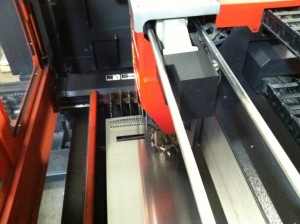I decided to participate in CQ Magazine’s World Wide CW (Morse Code) contest. It’s one of the, If not the biggest CW contest of the year.
I have been trying to learn CW off and on since the summer so I needed some help if I were to even make one QSO on CW. I setup N1MM logging software for the contest and used DM-780 that comes with Ham Radio Deluxe to decode and encode the CW.
Since I never participated in a CW contest before I wanted to see how it worked so I can configure my macros to work with the contest. I was very impressed on how fast contacts and exchanges are made. It’s way faster compared to SSB, RTTY and PSK31 and I felt even more compelled to learn CW after playing in this contest. I worked the contest off and on so I wouldn’t get overwhelmed about the activity. I started off searching and pouncing (S&P) on only the strongest signals. I would wait until I have their full call and exchange before even attempting to contact the station. N1MM does help out by looking up the CQ zone which came in handy a couple of times. After establishing contact I would get the typical 599 and zone exchange. After the first night working the contest. I have learned what my new call sounds coming back to me and phrases like “TU”, “TEST”, “?” and some of the shortcuts ops used to make a faster contact like instead of a RST of 599, it will be 5NN and A5 would be zone 15. I went to bed with code buzzing around in my head. I woke up the next day to play again. I’ve managed to make 100 contacts even though I know for a fact that I can make more. I just wanted to see what it was like to play in a CW and I liked it. Nothing like just jumping right in with both feet and absorbing everything. Once you learn the key terms in code the contest went much easier. I would encourage ops who want to learn CW to work in a contest. After learning what some of the stuff sounds like, the only trouble would be on decoding the call sign. I just hope that the people on the other end got my call right.
This now leads me to my rant. I lurk around on a lot of Ham radio related forums and also hear it by ear. I see a lot of people saying something along the lines of “These No-Coders are going to ruin HF” and “Amateur Radio is going to be just like CB” because the FCC dropped the Morse code requirement years after many other countries dropped the requirement. Now all these “Techies” or Technician license holders are upgrading to general and/or extra without passing a Morse code proficiency test.
After spending a couple of years on HF I have not seen much (or any) evidence to support this claim that has been spewing out of the elders mouths for over 4 years now. A lot of the Issues I see have a lot to do with elder hams. For example, when it comes to contacting a DX station I see a lot of things happening. Things like after the DX station acknowledge someone, there are still people trying to crowbar their callsign in because there is a second of silence. I also hear 1KW amps tuning up RIGHT on frequency of the DX station then spew out their call (like we don’t know who you are when you’re 40+ on my meter). Then you got those that see a massive pileup trying to contact the station and when acknowledged, will try to strike up a rag chew session by describing their town and the weather and their medical ailments even though there are 100’s of people waiting. And if the DX working split… FORGET ABOUT IT! They endlessly send their call even though you have a bunch of people telling him that the DX is listening 5KC up. Try listening to the RX Frequency of the DX station working spilt. Wholly crap there are a lot of people who don’t even come close to following the DX code of conduct. I’ve jotted a bunch of these calls down and looked them up on QRZ to find out that a majority of them are elder hams (By the age of their call and station setup).
For a Hobby that is so-called “Dying”, I wouldn’t spend much time complaining about those who are actually trying to stay interested in Ham radio. Not only should you welcome these “No-Coders”, you should thank them for showing interest. Because with that negative attitude you will drive away the young Hams that are genuinely interested and you will see a truly dead hobby. After a couple of years on HF and thousands of contacts, It’s rare that I run into someone around my age (28). I basically think that those who bitch and moan about it are just jealous or feel that they are “A class of their own” because they had to pass a 20wpm (or 5wpm) CW proficiency test. The funny thing is that since I’ve upgraded, I wanted to learn CW more than ever so I can make even more contacts farther away.
This is just my personal opinion, I could be wrong.































